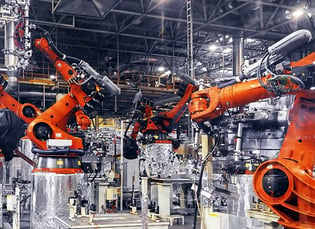Increase Profitability Through Smooth Production Processes
Robin Hornung - July 08, 2021

Two events that came virtually out of nowhere have shown many companies how vulnerable their production logistics are: the onset of the Corona crisis with the first lockdown in April 2020 and the blockade of shipping in the Suez Canal by the container ship "Ever Given" a few weeks ago. These events have made it clear to many companies that they need to move away from Excel solutions or individual subsystems - toward an integrated and unified planning system.
How an Integrated S&OP Plan also Makes the Supply Chain More Resilient
The challenges companies faced in the wake of the first lockdown are well known. Sales forecasts had to be revised downward by 30 percent or more. At short notice, plants were closed, employees were put on short-time work, supply networks had significant synchronization problems, and some companies had to launch emergency plans. In April of this year, the days-long traffic jam in the Suez Canal caused parts bottlenecks for more than just automotive manufacturers.
An integrated solution of Sales & Operation Planning (S&OP) and Supply Chain Management would have allowed affected companies to react quickly to these significant impacts and reschedule both the internal and external network. In addition, such a solution would have provided valuable insights into which parts would be missing or delayed and would have shown alternatives for production planning depending on parts supply.
Integration Instead of a Stand-Alone Solution
The key to smooth production logistics is to link planning and execution in order to keep an eye on the operational handling of production as well as on medium- and long-term planning (execution and ordering). In this approach, the current status of inventories, sales, and planned logistics are always the starting point for planning into the future. If, for example, changed inventory information is available at the end of the month following new sales, then the solution immediately updates the overall system so that this status can form the basis for further production planning.
In this integrated approach, it is not just production or logistics that are considered, but the entire process. One cog must mesh with the other: sales plans, sales quantities, and orders for ideal market supply from production. The production planner creates the plan for the produ ction of primary products and then passes it on to logistics, purchasing, and scheduling for the planning of the supply network. At this point, logistics must know, for example, what degree of flexibility the system requires to be able to optimally plan the supply network, including transportation. Finally, collaborative decision-making rounds off this process. Here, the departments/trades involved decide where to invest: in capacity or distribution. If inventories are too high, a marketing campaign can drive sales. The goal of this process is a settled S&OP plan. The plan, which has been approved by all departments involved, is accompanied by strict control, including monetary evaluations. Plan alternatives can be selected so that the most profitable plans are displayed in the system and, for example, investments are secured.
ction of primary products and then passes it on to logistics, purchasing, and scheduling for the planning of the supply network. At this point, logistics must know, for example, what degree of flexibility the system requires to be able to optimally plan the supply network, including transportation. Finally, collaborative decision-making rounds off this process. Here, the departments/trades involved decide where to invest: in capacity or distribution. If inventories are too high, a marketing campaign can drive sales. The goal of this process is a settled S&OP plan. The plan, which has been approved by all departments involved, is accompanied by strict control, including monetary evaluations. Plan alternatives can be selected so that the most profitable plans are displayed in the system and, for example, investments are secured.
In doing so, the S&OP system identifies and visualizes mismatches: where are requirements and capacities not synchronized, where do they not match, where is there too much inventory, where is a bottleneck to be expected as requirements increase?
Planning in Scenarios
Suppose you want to set up such a solution in a company. In that case, you first have to map any product structure in it, from primary products in all their variants to bills of materials broken down into parts requirements, which are manufactured on your own factory floors or supplied by third-party suppliers. Then different networks have to be modeled, such as the sales structure or the supplier network. This starts at the lowest level, at the retail point, which can be, for example, a car dealer or a distributor or an importer or an entire country or continental organization. Local planning steps take place at all nodes of the hierarchies in the distribution network. While the dealer plans only his own sales, the country organization of a company makes sure that complementary product mixes are available at the dealers and that the entire country is profitable as a market.
The information stored here forms the basis for the planning or the planning objects. For these objects, the software automatically provides interfaces to read in or export data. Time characteristics can be configured as desired, up to 15 years into the future and up to five years into the past. The planning itself can be done in daily, weekly, monthly, or even seasonal slices.
Once all the planning structures have been set up, the functional modules such as the planning parameters, a capacity engine for mapping the restrictions, or scenario management automatically take effect. To this end, the solution customized for the company can be duplicated as often as required. With this copy, the production planner runs through different scenarios, detached from the productive operation. Only when they have found the best scenario is it activated for productive operation.
Various other functions help the production planner adapt to fluctuations in demand, thus changing requirements and capacities at all product levels, for all markets, and all production resources, usually even automatically. In this way, "intelligent ordering" calculates, based on sales requirements and characteristics of the supply chain from the plants to the point of sale, at what time production should ideally occur so that the products are in the markets at the right time.
If multiple plants can manufacture a product, an intelligent mechanism helps select the right production line or plant for production. Using parameters such as capacity utilization and security of supply, the production planner selects the sites or locations where demand is backed by capacity. Working time calendars and a BI tool for analyzing data by production and sales characteristics round out the functionality. In production program planning, traffic light logic signals whether requirements, inventories, and capacities are optimally balanced. In the event of fluctuations in demand, the corresponding dashboard clearly shows the changing requirements and capacities at all product levels - and determines any necessary adjustments for all markets and all production resources.
production line or plant for production. Using parameters such as capacity utilization and security of supply, the production planner selects the sites or locations where demand is backed by capacity. Working time calendars and a BI tool for analyzing data by production and sales characteristics round out the functionality. In production program planning, traffic light logic signals whether requirements, inventories, and capacities are optimally balanced. In the event of fluctuations in demand, the corresponding dashboard clearly shows the changing requirements and capacities at all product levels - and determines any necessary adjustments for all markets and all production resources.
Integration is Key
A modern integrated S&OP system brings together all relevant information and compiles it on different views to optimally support management decision-making. A company can only increase its profitability if no sales are lost and all optimization opportunities are highlighted so that no capacities remain unused. Because the system always has all the latest information at its disposal, it is possible to react quickly to changing conditions and reschedule at any time. What's more, especially in exceptional situations such as those described at the beginning, such a system is invaluable for the comprehensive analysis of changing demand and capacity situations. It helps balance requirements and capacities and adjusts planning very quickly - at any time and every important adjusting screw in the company.
LATEST POSTS
- Understand Circular Economy in The Manufacturing Industry
- How Can Industry 4.0 IT Integration Be Achieved Smoothly?
- The Significance of Order Sequencing in Discrete Manufacturing
- How to improve your Supply Chain Management: The Power of Control Towers
- Optimizing Human Resource Scheduling in Manufacturing: A Technological Approach


